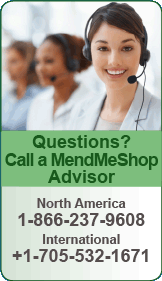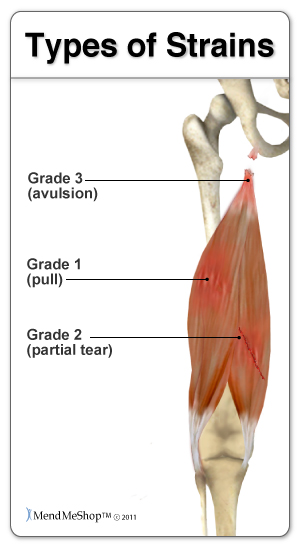Hamstring Strain Progression
There are varying degrees of pulled hamstring muscles. The strain is classified by how severe the damage to the hamstring is.
Mild Hamstring Pull
This is also known as a 'Grade I' tear. A mild strain is classified as the overstretching of the fibers of the muscle or tendon. This type of strain causes discomfort in the upper thigh (and possibly lower back) area as opposed to acute pain. You will generally feel some specific point pain, tightness or mild cramping in your hamstring which will be a little uncomfortable, but will involve no swelling or no major loss of strength. These may diminish with activity, but will may return easily with further activity.
Hamstring Tear
This is also known as a 'Grade II' tear and is an actual tearing of the fibers in the muscle and/or tendon. It would feel like a sharp pain in the back of the leg and you may hear a tearing sound at the time of the injury. There will be a visible hamstring contusion, or bruising, in the torn muscle area in the days following the injury. You will generally experience some pain that radiates down your leg during activity, while bending your knee against resistance, or when you touch your hamstring. Swelling, stiffness, decreased strength and range of motion (may not be able to straighten knee) will be apparent and can also cause you to limp. You may also experience some bruising (ecchymosis) due to bleeding within the injured muscle.
Hamstring Rupture
This is also known as a 'Grade III' tear. When a muscle ruptures, or tears completely, you will feel a very sharp pain at the point of the tear and you may hear or feel a 'pop'. A hamstring rupture will involve a complete tear of your hamstring muscle fibers where the muscle belly attaches to the tendon or where you muscle belly rips into 2 separate pieces. This is often very painful and occurs rarely compared to other degrees of strain/tearing. If you have a multi-muscle tear, it normally occurs at the point where your hamstring tendons and muscles meet near the ischium. There will be a significant amount of pain when attempting to move the leg and your range of motion will be limited. There will be a noticeable contusion (hamstring bruising) and swelling. Treatment of a complete tear usually requires surgery to re-join the muscle tissue at the point of the tear.
The majority of hamstring strains are grade 1 or 2 strains that involve partial muscle or tendon tears that occur near the musculotendinous junction, where your hamstring tendon and muscle meet.
Should You Seek Medical Attention for a Hamstring Strain?
This is up to your discretion; however any continued discomfort in your hamstring should be investigated. If you continue to experience the hamstring injury symptoms and have tried the suggested conservative treatments for 2-3 weeks, it is recommended that you seek professional medical attention. It is recommended you seek immediate attention if you:
- hear a "loud pop" in your muscle when injured
- have immediate severe pain, swelling or discoloration in your hamstrings
- experience severe weakness in your leg (compared to other leg) and have difficulty walking
- have a temperature over 100.4° F (38° C)
- notice blue toe nails, numbness or coldness below your injury
Learn More About Hamstring Strain
Hamstring Strain Causes
Hamstring Strain Symptoms
Hamstring Strain Progression (Grades of Strain)
Hamstring Strain Diagnosis
Hamstring Strain Home Treatments
Hamstring Strain Surgery
Hamstring Strain Post-Surgery Recovery
Hamstring Strain Prevention
Product specialists are available 9:00 am to 5:00 pm Eastern Standard Time Monday to Friday. If any question or concern arises, call us or simply send us an email at any time (we check our emails constantly all throughout the day and night.. even on holidays!). We will respond as soon as possible. North America Toll Free 1-866-237-9608
Outside North America +1-705-532-1671
Learn More About Hamstring Injuries & TreatmentsI want to learn more about Hamstring Post-Surgery Recovery I want to learn more about the TShellz® Circulatory Boost Wrap I want to learn more about Ice & Heat: Which Is Better For Treatment? I want to learn more about Stretching for the Hamstring I want to learn more about Soft Tissue Injury Treatments
During your recovery, you will probably have to modify and/or eliminate any activities that cause pain or discomfort at the location of your soft tissue injury until the pain and inflammation settle. Always consult your doctor and/or Physical Therapist before using any of our outstanding products, to make sure they are right for you and your condition. The more diligent you are with your treatment and rehabilitation, the faster you will see successful results!
| 




